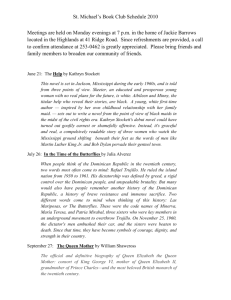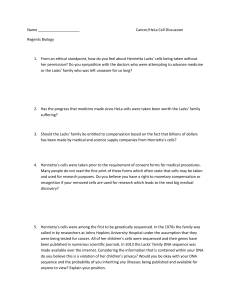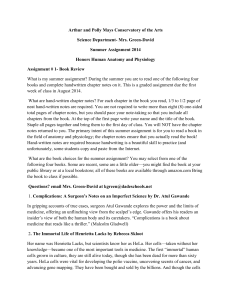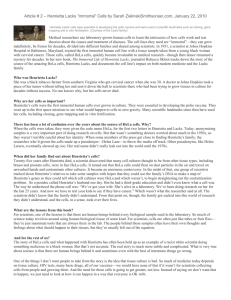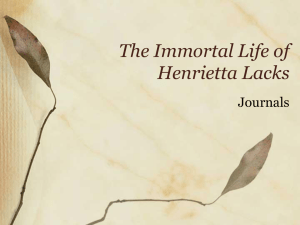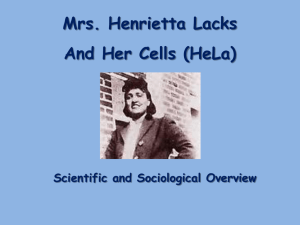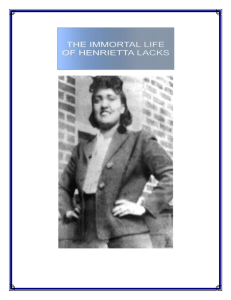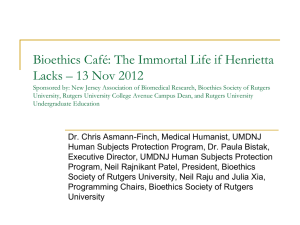Using Seed Texts as Springboards to Research
advertisement
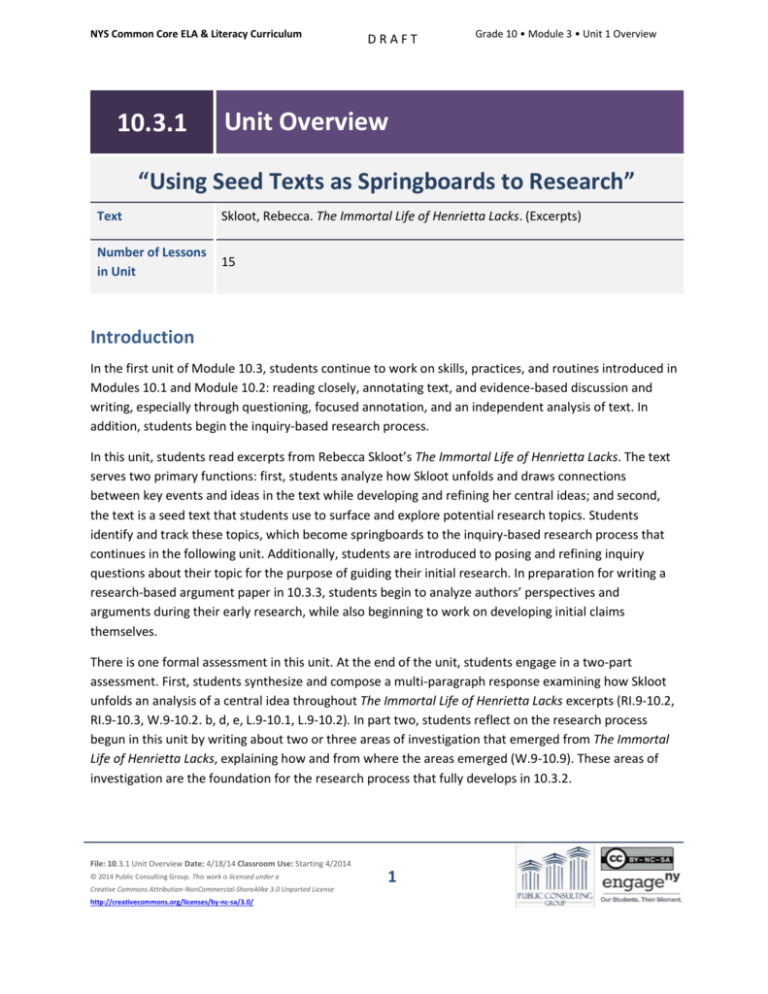
NYS Common Core ELA & Literacy Curriculum 10.3.1 DRAFT Grade 10 • Module 3 • Unit 1 Overview Unit Overview “Using Seed Texts as Springboards to Research” Text Skloot, Rebecca. The Immortal Life of Henrietta Lacks. (Excerpts) Number of Lessons in Unit 15 Introduction In the first unit of Module 10.3, students continue to work on skills, practices, and routines introduced in Modules 10.1 and Module 10.2: reading closely, annotating text, and evidence-based discussion and writing, especially through questioning, focused annotation, and an independent analysis of text. In addition, students begin the inquiry-based research process. In this unit, students read excerpts from Rebecca Skloot’s The Immortal Life of Henrietta Lacks. The text serves two primary functions: first, students analyze how Skloot unfolds and draws connections between key events and ideas in the text while developing and refining her central ideas; and second, the text is a seed text that students use to surface and explore potential research topics. Students identify and track these topics, which become springboards to the inquiry-based research process that continues in the following unit. Additionally, students are introduced to posing and refining inquiry questions about their topic for the purpose of guiding their initial research. In preparation for writing a research-based argument paper in 10.3.3, students begin to analyze authors’ perspectives and arguments during their early research, while also beginning to work on developing initial claims themselves. There is one formal assessment in this unit. At the end of the unit, students engage in a two-part assessment. First, students synthesize and compose a multi-paragraph response examining how Skloot unfolds an analysis of a central idea throughout The Immortal Life of Henrietta Lacks excerpts (RI.9-10.2, RI.9-10.3, W.9-10.2. b, d, e, L.9-10.1, L.9-10.2). In part two, students reflect on the research process begun in this unit by writing about two or three areas of investigation that emerged from The Immortal Life of Henrietta Lacks, explaining how and from where the areas emerged (W.9-10.9). These areas of investigation are the foundation for the research process that fully develops in 10.3.2. File: 10.3.1 Unit Overview Date: 4/18/14 Classroom Use: Starting 4/2014 © 2014 Public Consulting Group. This work is licensed under a Creative Commons Attribution-NonCommercial-ShareAlike 3.0 Unported License http://creativecommons.org/licenses/by-nc-sa/3.0/ 1 NYS Common Core ELA & Literacy Curriculum DRAFT Grade 10 • Module 3 • Unit 1 Overview Note: This unit suspends Accountable Independent Reading (AIR). Students are held accountable for building a volume of independent reading as they independently read The Immortal Life of Henrietta Lacks for homework. Additionally, students are expected to read outside sources as they explore potential areas of investigation for research. Literacy Skills and Habits Read closely for textual details. Annotate texts to support comprehension and analysis. Engage in productive evidence-based discussions about text. Collect and organize evidence from texts to support analysis in writing. Collect and organize evidence from texts to support claims made in writing. Use vocabulary strategies to define unknown words. Identify potential topics for research within a text. Use questioning to guide research. Conduct pre-searches to validate sufficiency of information for exploring potential topics. Delineate arguments and explain relevant and sufficient evidence. Analyze perspectives in potential research texts. Standards for This Unit College and Career Readiness Anchor Standards for Reading None. CCS Standards: Reading — Literature None. CCS Standards: Reading — Informational Text RI.9-10.2 Determine a central idea of a text and analyze its development over the course of the text, including how it emerges and is shaped and refined by specific details; provide an objective summary of the text. RI.9-10.3 Analyze how the author unfolds an analysis or series of ideas or events, including the order in which the points are made, how they are introduced and developed, and the connections that are drawn between them. RI.9-10.4 Determine the meaning of words and phrases as they are used in a text, including figurative, connotative, and technical meanings; analyze the cumulative impact of File: 10.3.1 Unit Overview Date: 4/18/14 Classroom Use: Starting 4/2014 © 2014 Public Consulting Group. This work is licensed under a Creative Commons Attribution-NonCommercial-ShareAlike 3.0 Unported License http://creativecommons.org/licenses/by-nc-sa/3.0/ 2 NYS Common Core ELA & Literacy Curriculum DRAFT Grade 10 • Module 3 • Unit 1 Overview specific word choices on meaning and tone (e.g., how the language of a court opinion differs from that of a newspaper). RI.9-10.5 Analyze in detail how an author’s ideas or claims are developed and refined by particular sentences, paragraphs, or larger portions of a text (e.g., a section or chapter). RI.9-10.6 Determine an author’s point of view or purpose in a text and analyze how an author uses rhetoric to advance that point of view or purpose. RI.9-10.8 Delineate and evaluate the argument and specific claims in a text, assessing whether the reasoning is valid and the evidence is relevant and sufficient; identify false statements and fallacious reasoning. CCS Standards: Writing W.9-10.2 b, d, e Write informative/explanatory texts to examine and convey complex ideas, concepts, and information clearly and accurately through the effective selection, organization, and analysis of content. b. Develop the topic with well-chosen, relevant, and sufficient facts, extended definitions, concrete details, quotations, or other information and examples appropriate to the audience's knowledge of the topic. d. Use precise language and domain-specific vocabulary to manage the complexity of the topic. e. Establish and maintain a formal style and objective tone while attending to the norms and conventions of the discipline in which they are writing. W.9-10.4 Produce clear and coherent writing in which the development, organization, and style are appropriate to task, purpose, and audience. W.9-10.9.b Draw evidence from literary or informational texts to support analysis, reflection, and research. b. Apply grades 9-10 Reading standards to literary nonfiction (e.g., “Delineate and evaluate the argument and specific claims in a text, assessing whether the reasoning is valid and the evidence is relevant and sufficient; identify false statements and fallacious reasoning”). CCS Standards: Speaking & Listening SL.9-10.1.a, c Initiate and participate effectively in a range of collaborative discussions (one-on-one, in groups, and teacher-led) with diverse partners on grades 9–10 topics, texts, and issues, building on others’ ideas and expressing their own clearly and persuasively. a. Come to discussions prepared, having read and researched material under study; explicitly draw on that preparation by referring to evidence from texts and other File: 10.3.1 Unit Overview Date: 4/18/14 Classroom Use: Starting 4/2014 © 2014 Public Consulting Group. This work is licensed under a Creative Commons Attribution-NonCommercial-ShareAlike 3.0 Unported License http://creativecommons.org/licenses/by-nc-sa/3.0/ 3 NYS Common Core ELA & Literacy Curriculum DRAFT Grade 10 • Module 3 • Unit 1 Overview research on the topic or issue to stimulate a thoughtful, well-reasoned exchange of ideas. c. Propel conversations by posing and responding to questions that relate the current discussion to broader themes or larger ideas; actively incorporate others into the discussion; and clarify, verify, or challenge ideas and conclusions. CCS Standards: Language L.9-10.1 Demonstrate command of the conventions of standard English grammar and usage when writing or speaking. L.9-10.2.a Demonstrate command of the conventions of standard English capitalization, punctuation, and spelling when writing. a. Use a semicolon (and perhaps a conjunctive adverb) to link two or more closely related independent clauses. L.9-10.4. a, c, d Determine or clarify the meaning of unknown and multiple-meaning words and phrases based on grades 9–10 reading and content, choosing flexibly from a range of strategies. a. Use context (e.g., the overall meaning of a sentence, paragraph, or text; a word's position or function in a sentence) as a clue to the meaning of a word or phrase c. Consult general and specialized reference materials (e.g., dictionaries, glossaries, thesauruses), both print and digital, to find the pronunciation of a word or determine or clarify its precise meaning, its part of speech, or its etymology. d. Verify the preliminary determination of the meaning of a word or phrase (e.g., by checking the inferred meaning in context or in a dictionary). L.9-10.5.a Demonstrate understanding of figurative language, word relationships, and nuances in word meanings. a. Interpret figures of speech (e.g., euphemism, oxymoron) in context and analyze their role in the text. Note: Bold text indicates targeted standards that will be assessed in the unit. File: 10.3.1 Unit Overview Date: 4/18/14 Classroom Use: Starting 4/2014 © 2014 Public Consulting Group. This work is licensed under a Creative Commons Attribution-NonCommercial-ShareAlike 3.0 Unported License http://creativecommons.org/licenses/by-nc-sa/3.0/ 4 NYS Common Core ELA & Literacy Curriculum DRAFT Grade 10 • Module 3 • Unit 1 Overview Unit Assessments Ongoing Assessment Standards Assessed RI.9-10.2, RI.9-10.3, RI.9-10.4, RI.9-10.5, RI.9-10.6, RI.9-10.8, W.9-10.9.b, L.9-10.2 Description of Assessment Varies by lesson but may include short written responses to questions focused on how the author unfolds events or ideas, develops and refines a central idea, or advances her purpose. This may also include the development of factual, interpretive, and evaluative questions for further exploration of research topics and pre-searches to narrow down selected areas of investigation. End-of-Unit Assessment Standards Assessed RI.9-10.2, RI.9-10.3, W.9-10.2.b, d, e, W.9-10.9.b, L.9-10.1, L.9-10.2 Description of Assessment Part 1: Choose one central idea that Skloot develops in the text. How does Skloot unfold an analysis of this central idea? Part 2: Articulate two to three areas of investigation and where they emerge from the text. Unit-at-a-Glance Calendar Lesson Text Learning Outcomes/Goals 1 The Immortal Life of Henrietta Lacks, pp. 1–4 In this first lesson of the unit and module, students are introduced to the module’s focus: inquiry-based research to build evidence-based arguments. Students begin reading and analyzing the Prologue of The Immortal Life of Henrietta Lacks, focusing on the connection between Henrietta Lacks and the scientific advancement provided by the research of her “immortal” cells. This excerpt focuses on the connections Skloot draws between Henrietta Lacks, as a person, and the scientific advancement her cells supported. File: 10.3.1 Unit Overview Date: 4/18/14 Classroom Use: Starting 4/2014 © 2014 Public Consulting Group. This work is licensed under a Creative Commons Attribution-NonCommercial-ShareAlike 3.0 Unported License http://creativecommons.org/licenses/by-nc-sa/3.0/ 5 NYS Common Core ELA & Literacy Curriculum DRAFT Grade 10 • Module 3 • Unit 1 Overview Lesson Text Learning Outcomes/Goals 2 The Immortal Life of Henrietta Lacks, pp. 27–33 In this lesson, students read and analyze another excerpt from The Immortal Life of Henrietta Lacks, in which Skloot further surfaces ideas and events related to the story of Henrietta Lacks and her “contribution” to human tissue research. Students analyze the text through reading and evidence-based discussions, with specific attention paid to how Skloot unfolds the series of events and ideas by using a Tracking Events and Ideas Tool. 3 The Immortal Life of Henrietta Lacks, pp. 63–66 In this lesson, students continue to read and analyze The Immortal Life of Henrietta Lacks, focusing on how Skloot provides a narrative account of Henrietta’s deteriorating health. In small groups, students explore the care Henrietta receives from the Johns Hopkins medical staff through analysis of Skloot’s specific word choice and purposeful use of language. Additionally, students begin the research process by learning how to surface issues and pose inquiry questions using a Surfacing Issues Tool and Posing Inquiry Questions Handout. 4 The Immortal Life of Henrietta Lacks, pp. 93–102 In this lesson, students read another excerpt from The Immortal Life of Henrietta Lacks, building their understanding of central ideas present in the text as they examine the history of HeLa through the lens of scientific discovery. Students discuss their understanding in pairs and continue to surface issues in the text for the purpose of research. Students also continue to generate, refine and select inquiry questions to guide their research. 5 The Immortal Life of Henrietta Lacks, pp. 127–136 In this lesson, students continue to read and analyze another excerpt from The Immortal Life of Henrietta Lacks, in which Skloot describes cases of HeLa cell misuse and explores issues of informed consent and human experimentation. Students explore this passage through a series of questions and discussion, in which they analyze how Skloot supports a perspective through description and use of language. Students continue to surface issues that emerge from the text and record these issues on their Surfacing Issues Tool. File: 10.3.1 Unit Overview Date: 4/18/14 Classroom Use: Starting 4/2014 © 2014 Public Consulting Group. This work is licensed under a Creative Commons Attribution-NonCommercial-ShareAlike 3.0 Unported License http://creativecommons.org/licenses/by-nc-sa/3.0/ 6 NYS Common Core ELA & Literacy Curriculum DRAFT Grade 10 • Module 3 • Unit 1 Overview Lesson Text Learning Outcomes/Goals 6 The Immortal Life of Henrietta Lacks, pp. 127–136 In this lesson, students reread the excerpt from the previous lesson, focusing on identifying and delineating one of Skloot’s claims, and assessing whether it is relevant and sufficient to support the claim. Student groups identify and delineate one of Skloot’s claims and evaluate evidence that she uses in pages 127–136 to support her claim. Students participate in collaborative group discussion and synthesize their findings on the Lesson 6 Evidence Collection Tool. 7 The Immortal Life of Henrietta Lacks, pp. 164–169 In this lesson, students continue reading an excerpt from The Immortal Life of Henrietta Lacks, focusing on the Lacks family’s distrust of Johns Hopkins Hospital and the history of unethical medical practices conducted against the AfricanAmerican community. Students analyze how Skloot unfolds credible and relevant evidence to support the perspective of the Lacks family. Students also continue searching for topics/issues using the Surfacing Issues Tool, and are introduced to the Exploring a Topic Tool, in which they consider their own reasons for selecting various topics to further explore in research. 8 The Immortal Life of Henrietta Lacks, pp. 179–183 In this lesson, students read and analyze an excerpt from the text that describes how the Lacks family discovers the HeLa cells, and how the research community makes use of the Lacks family’s DNA to untangle a cell culture contamination problem. Students read and analyze the text, and work to identify a central idea based on specific details. Students are introduced to the pre-search process and the Pre-Search Tool. 9 The Immortal Life of Henrietta Lacks, pp. 194–198 In this lesson, students analyze an excerpt in which Skloot describes how the family struggles to understand the public information regarding the HeLa cells. Students continue to build their understanding of how specific sections of text develop, and refine specific ideas that have emerged in the larger text. Students also continue to pre-search topics/issues that interest them and gather potential sources for their research. Students begin the vocabulary journal. File: 10.3.1 Unit Overview Date: 4/18/14 Classroom Use: Starting 4/2014 © 2014 Public Consulting Group. This work is licensed under a Creative Commons Attribution-NonCommercial-ShareAlike 3.0 Unported License http://creativecommons.org/licenses/by-nc-sa/3.0/ 7 NYS Common Core ELA & Literacy Curriculum DRAFT Grade 10 • Module 3 • Unit 1 Overview Lesson Text Learning Outcomes/Goals 10 The Immortal Life of Henrietta Lacks, pp. 199–201 In this lesson, students examine an excerpt that introduces the story of John Moore, whose cells were used to develop the cell line Mo, without his knowledge, after he received treatment for cancer. Students compare this story to that of Henrietta Lacks through text analysis. After reading, students learn about the concept of perspective and continue with their pre-searches. 11 The Immortal Life of Henrietta Lacks, pp. 201–206 In this lesson, students continue to examine the excerpt that details the court hearings of John Moore and presents multiple perspectives on the issue of cell tissue ownership. Students consider how the information in this excerpt impacts their developing understanding of tissue ownership. Students continue to conduct pre-searches for homework. 12 The Immortal Life of Henrietta Lacks, pp. 245– 247; 261–267 In this lesson, students read two excerpts. The first describes Skloot’s encounter with Zakariyya (Henrietta’s son), when he discusses his anger with the Hopkins’ scientists. The second describes a visit that Skloot, Deborah, and Zakariyya make to Hopkins to meet a scientist, who ends up being surprisingly kind to the Lacks family. Students consider how this excerpt affects Zakariyya’s ideas about the medical community. Students continue to pre-search areas of investigation or homework. 13 The Immortal Life of Henrietta Lacks (all excerpts) In this lesson, students engage in an evidence collection activity using The Immortal Life of Henrietta Lacks, in order to prepare for a discussion in the following lesson about the text’s various claims and evidence. The focus of this lesson is on understanding claims and evidence in informational text, as well as developing claims for future argument writing. Additionally, this lesson develops students’ proficiency for gathering and synthesizing evidence from a text. File: 10.3.1 Unit Overview Date: 4/18/14 Classroom Use: Starting 4/2014 © 2014 Public Consulting Group. This work is licensed under a Creative Commons Attribution-NonCommercial-ShareAlike 3.0 Unported License http://creativecommons.org/licenses/by-nc-sa/3.0/ 8 NYS Common Core ELA & Literacy Curriculum DRAFT Grade 10 • Module 3 • Unit 1 Overview Lesson Text Learning Outcomes/Goals 14 The Immortal Life of Henrietta Lacks (all excerpts) In this lesson, students build upon the evidence collection work done in the previous lesson by engaging in a group discussion that validates their understanding of evidence used to support claims found in The Immortal Life of Henrietta Lacks. Within expert groups, students take turns presenting their claim and evidence to the other members of their group, allowing time for counterclaims and clarifying questions. As an assessment, students write a paragraph response that synthesizes their understanding of supporting evidence with their ability to identify a claim in the text, and determine whether the evidence provided is relevant and sufficient. 15 The Immortal Life of Henrietta Lacks (all excerpts) In this final lesson of the unit, the End-of-Unit Assessment, students complete a two-part assessment. First, students synthesize and compose a multi-paragraph response examining how Skloot unfolds an analysis of a central idea throughout The Immortal Life of Henrietta Lacks. In part two, students reflect on the research process begun in this unit by writing about two or three areas of investigation that emerged from The Immortal Life of Henrietta Lacks, explaining how and from where the areas emerged. Preparation, Materials, and Resources Preparation Read and annotate excerpts from The Immortal Life of Henrietta Lacks. Review the Short Response Rubric and Checklist. Review all unit standards and post in classroom. Consider creating a word wall of the vocabulary provided in all lessons. Materials and Resources Chart paper Copies of the text The Immortal Life of Henrietta Lacks File: 10.3.1 Unit Overview Date: 4/18/14 Classroom Use: Starting 4/2014 © 2014 Public Consulting Group. This work is licensed under a Creative Commons Attribution-NonCommercial-ShareAlike 3.0 Unported License http://creativecommons.org/licenses/by-nc-sa/3.0/ 9 NYS Common Core ELA & Literacy Curriculum DRAFT Grade 10 • Module 3 • Unit 1 Overview Writing utensils including pencils, pens, markers, and highlighters Methods for collecting student work: student notebooks, folders, etc. Access to technology (if possible): interactive whiteboard, document camera, and LCD projector Copies of handouts and tools for each student: see Materials list in individual lesson plans Copies of the 10.3.1 End-of-Unit Text Analysis Rubric and Checklist Copies of the Short Response Rubric and Checklist Self-stick notes for students (optional) Copies of the Speaking and Listening Rubric and Checklist for standard SL.9-10.1.a, c for each student Copies of the 10.3.1 Unit Glossary File: 10.3.1 Unit Overview Date: 4/18/14 Classroom Use: Starting 4/2014 © 2014 Public Consulting Group. This work is licensed under a Creative Commons Attribution-NonCommercial-ShareAlike 3.0 Unported License http://creativecommons.org/licenses/by-nc-sa/3.0/ 10
